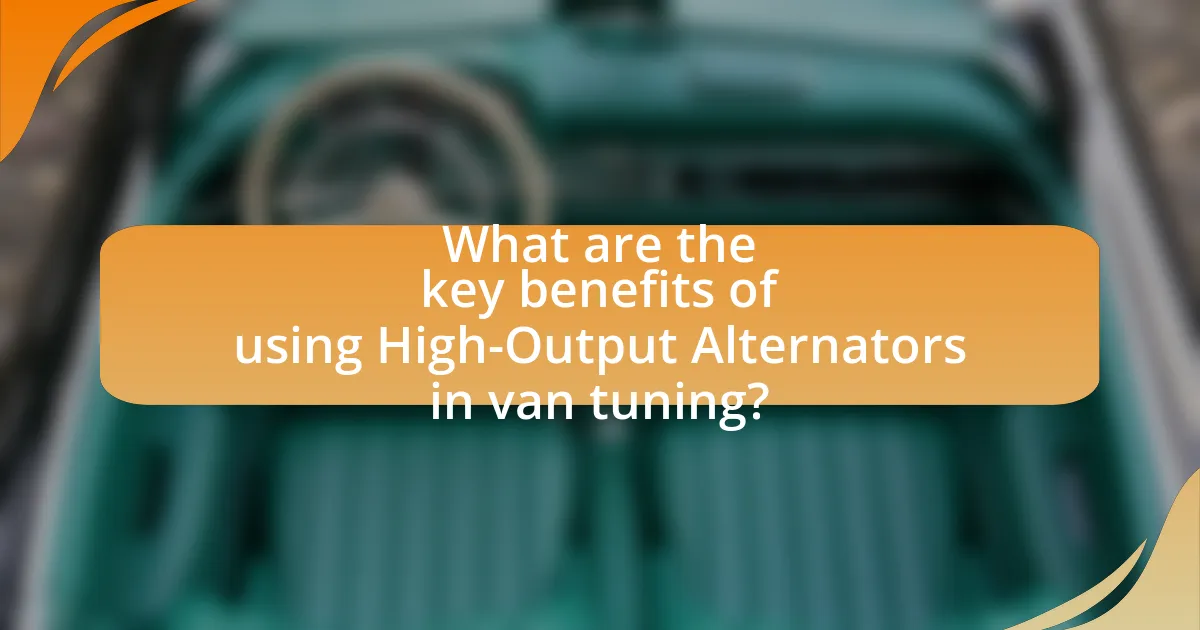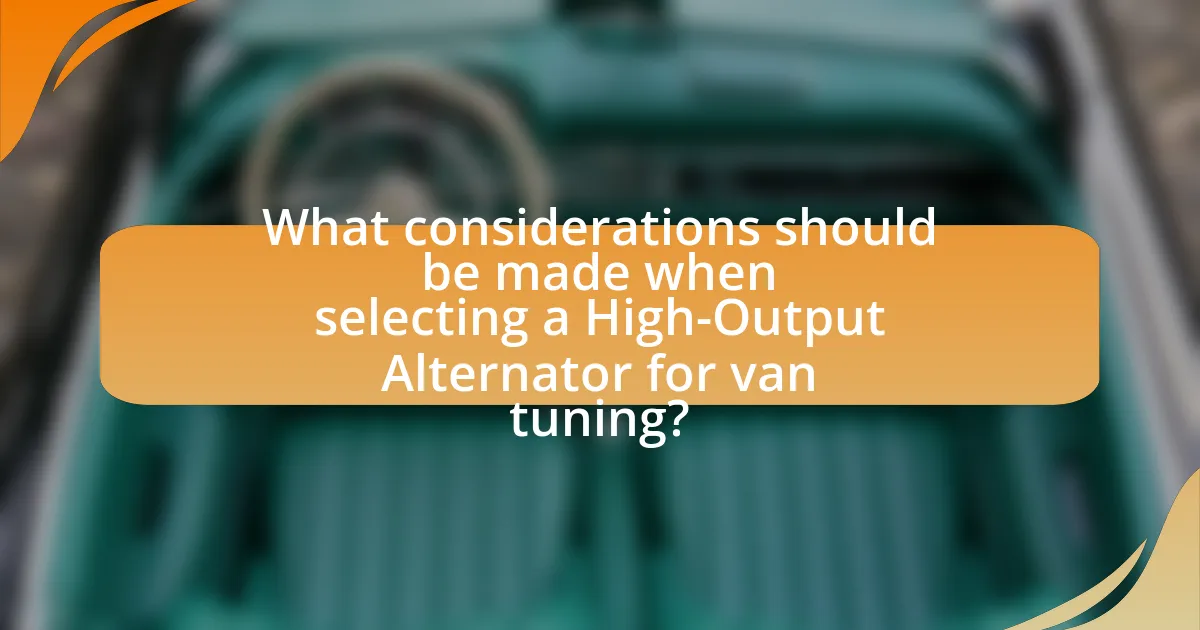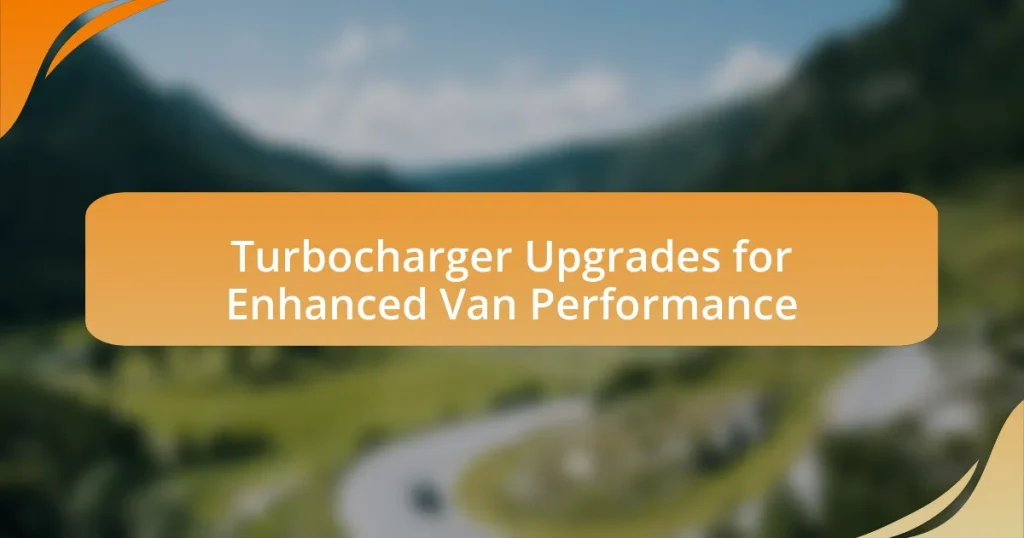High-output alternators are specialized electrical components that generate significantly more electrical current than standard alternators, typically exceeding 200 amps. They play a vital role in van tuning by providing the necessary power to support high-demand accessories such as upgraded audio systems, lighting, and other electronic devices, ensuring stable and reliable electrical performance. The article explores the differences between high-output and standard alternators, their specifications, and the benefits they offer for enhanced vehicle performance, battery life, and overall reliability in modified vans. Additionally, it addresses common misconceptions, installation considerations, and maintenance practices to maximize the advantages of high-output alternators in van tuning.

What are High-Output Alternators and Their Role in Van Tuning?
High-output alternators are electrical components designed to produce a greater amount of electrical current than standard alternators, typically exceeding 200 amps. Their role in van tuning is crucial as they provide the necessary power to support additional electrical accessories and modifications, such as high-performance audio systems, lighting, and other electronic devices that require significant power. This increased output ensures that the van’s electrical system remains stable and functional, preventing issues like battery drain and electrical failures during operation. High-output alternators are particularly beneficial in customized vans where power demands exceed the capabilities of factory-installed alternators, thereby enhancing overall performance and reliability.
How do High-Output Alternators differ from standard alternators?
High-output alternators differ from standard alternators primarily in their ability to produce a significantly higher electrical output, often exceeding 200 amps compared to the typical 60-100 amps of standard models. This increased output is essential for vehicles with extensive electrical systems, such as those used in van tuning, where additional power is required to support high-demand accessories like sound systems, lighting, and other electronic devices. High-output alternators achieve this through enhanced winding designs and improved cooling mechanisms, allowing them to maintain performance under heavy loads.
What specifications define a high-output alternator?
A high-output alternator is defined by its ability to produce a significantly higher amperage output than standard alternators, typically exceeding 150 amps. This increased output is crucial for powering additional electrical accessories in modified vehicles, such as high-performance audio systems, lighting, and other aftermarket components. High-output alternators often feature larger windings, improved cooling systems, and advanced materials to enhance efficiency and durability, ensuring they can sustain higher loads without overheating. For instance, many high-output alternators are designed to operate effectively at higher RPMs, providing consistent power delivery even under demanding conditions.
How does the design of high-output alternators enhance performance?
The design of high-output alternators enhances performance by increasing the electrical output at lower engine RPMs, which is crucial for powering additional accessories in modified vehicles. This is achieved through features such as larger stator windings and improved magnetic materials, which allow for greater efficiency and higher current production. For instance, high-output alternators can produce up to 200 amps or more, compared to standard alternators that typically generate around 100 amps. This increased output ensures that all electrical components, including sound systems and lighting, operate optimally without straining the vehicle’s electrical system.
Why are High-Output Alternators important for van tuning?
High-output alternators are crucial for van tuning because they provide the necessary electrical power to support upgraded audio systems, lighting, and other accessories. Standard alternators often cannot meet the increased power demands of these enhancements, leading to battery drain and system failures. High-output alternators can deliver significantly more amperage, typically ranging from 150 to 300 amps, ensuring that all electrical components function optimally without compromising performance. This capability is essential for maintaining the reliability and efficiency of a tuned van, especially during high-demand situations like loud music playback or extensive lighting use.
What electrical demands do tuned vans typically have?
Tuned vans typically have increased electrical demands due to enhanced audio systems, additional lighting, and various electronic accessories. These modifications often require more power than standard electrical systems can provide, leading to the need for high-output alternators to meet the higher amperage requirements. For instance, a high-performance audio system can demand upwards of 1000 watts, translating to approximately 80-100 amps at 12 volts, which exceeds the capacity of factory alternators. This necessitates upgrades to ensure reliable power supply and prevent battery drain during operation.
How do high-output alternators meet these electrical demands?
High-output alternators meet electrical demands by generating significantly more amperage than standard alternators, allowing them to power multiple high-drain accessories simultaneously. These alternators are designed with advanced winding techniques and larger stator and rotor components, which enhance their efficiency and output capacity. For instance, while a typical alternator may produce around 60-100 amps, high-output models can deliver 200 amps or more, ensuring that systems such as sound systems, lighting, and other electronic devices receive adequate power without draining the vehicle’s battery. This capability is crucial in van tuning, where enhanced electrical systems are often installed to support various aftermarket modifications.

What are the key benefits of using High-Output Alternators in van tuning?
High-output alternators provide increased electrical power, which is essential for supporting additional accessories and modifications in van tuning. These alternators can deliver significantly higher amperage, often exceeding 200 amps, compared to standard alternators, which typically provide around 100 amps. This enhanced output ensures that high-demand electrical components, such as upgraded audio systems, lighting, and refrigeration units, operate efficiently without draining the vehicle’s battery. Furthermore, high-output alternators help maintain battery health by reducing the risk of undercharging, especially during prolonged use of electrical accessories.
How do High-Output Alternators improve overall vehicle performance?
High-output alternators improve overall vehicle performance by providing a greater electrical output, which ensures that all electrical components receive adequate power. This enhanced power supply supports high-demand accessories such as upgraded audio systems, lighting, and onboard electronics, preventing voltage drops that can lead to performance issues. For instance, a standard alternator may produce around 70-100 amps, while high-output alternators can deliver 200 amps or more, allowing for consistent operation of multiple high-draw devices simultaneously. This capability not only enhances the functionality of these accessories but also contributes to better engine performance by maintaining optimal voltage levels, thereby reducing strain on the vehicle’s electrical system.
What impact do they have on audio systems and accessories?
High-output alternators significantly enhance audio systems and accessories by providing a stable and increased power supply. This improved power delivery allows audio components, such as amplifiers and subwoofers, to operate at their optimal performance levels, resulting in clearer sound quality and higher volume output. Additionally, high-output alternators prevent voltage drops during heavy usage, which can lead to distortion or system shutdowns, ensuring that audio systems maintain consistent performance even under demanding conditions.
How do they affect engine performance and efficiency?
High-output alternators enhance engine performance and efficiency by providing a consistent and increased electrical output, which supports additional electrical components without straining the engine. This improved electrical supply allows for better operation of performance accessories, such as upgraded audio systems and lighting, which can otherwise draw power from the engine, leading to reduced efficiency. Studies indicate that maintaining optimal voltage levels through high-output alternators can improve fuel efficiency by ensuring that the engine runs smoothly without unnecessary load, thus optimizing combustion and reducing fuel consumption.
What advantages do High-Output Alternators provide for long-term use?
High-output alternators provide increased electrical capacity, which is essential for long-term use in vehicles with high-demand electrical systems. This enhanced capacity allows for the reliable operation of multiple accessories, such as upgraded audio systems, lighting, and other electronic devices, without straining the vehicle’s electrical system. Additionally, high-output alternators maintain optimal voltage levels even under heavy load, reducing the risk of battery depletion and extending battery life. Studies indicate that vehicles equipped with high-output alternators experience fewer electrical failures and improved performance in demanding conditions, supporting their advantages for long-term use.
How do they contribute to battery life and reliability?
High-output alternators contribute to battery life and reliability by providing a consistent and sufficient power supply to the battery, ensuring it remains charged even under heavy electrical loads. This consistent charging reduces the risk of battery depletion, which can lead to failure or reduced lifespan. Additionally, high-output alternators can maintain optimal voltage levels, preventing overcharging or undercharging, both of which can damage the battery. Studies indicate that vehicles equipped with high-output alternators experience fewer battery-related issues, enhancing overall reliability and performance.
What are the maintenance benefits associated with high-output alternators?
High-output alternators provide significant maintenance benefits by ensuring a consistent and reliable power supply to electrical systems in vehicles. This reliability reduces the risk of electrical failures, which can lead to costly repairs and downtime. Additionally, high-output alternators can support the increased electrical demands of modern accessories and equipment, minimizing strain on the vehicle’s electrical system. This reduced strain can lead to longer lifespans for both the alternator and other electrical components, ultimately lowering maintenance costs over time.

What considerations should be made when selecting a High-Output Alternator for van tuning?
When selecting a High-Output Alternator for van tuning, it is essential to consider the electrical load requirements of the van’s systems. This includes evaluating the total amperage needed for components such as audio systems, lighting, and other accessories. A high-output alternator should provide sufficient amperage to meet or exceed these demands, typically ranging from 150 to 300 amps, depending on the specific setup. Additionally, compatibility with the van’s existing electrical system, including mounting options and belt configuration, is crucial to ensure proper installation and functionality. Furthermore, the quality and reliability of the alternator, often indicated by brand reputation and warranty offerings, should also be assessed to avoid potential failures during operation.
What factors influence the choice of a high-output alternator?
The choice of a high-output alternator is influenced by several key factors, including the electrical load requirements of the vehicle, the type of accessories being powered, and the engine’s RPM range. Electrical load requirements dictate the total amperage needed to support components like sound systems, lighting, and other electronic devices. The type of accessories being powered, such as high-performance audio systems or additional lighting, can significantly increase the demand for electrical output. Additionally, the engine’s RPM range affects the alternator’s efficiency and output; high-output alternators are often designed to perform optimally at higher RPMs, ensuring that they can meet the increased power demands during operation.
How does vehicle type and usage affect alternator selection?
Vehicle type and usage significantly influence alternator selection by determining the electrical load requirements and space constraints. For instance, commercial vans often require high-output alternators to support additional accessories like refrigeration units or sound systems, while standard passenger vehicles may only need a standard alternator to power basic electrical components. The electrical demands of the vehicle, such as lighting, infotainment systems, and auxiliary equipment, dictate the amperage rating of the alternator needed. Additionally, vehicles used for heavy-duty applications or frequent stop-and-go driving may necessitate alternators with higher output to ensure reliable performance under varying load conditions.
What are the compatibility issues to consider with existing systems?
Compatibility issues to consider with existing systems include electrical load capacity, voltage regulation, and physical space constraints. High-output alternators may exceed the electrical load capacity of older systems, leading to potential failures or inefficiencies. Additionally, voltage regulation must be compatible; mismatched voltage levels can cause damage to sensitive electronic components. Physical space constraints are also critical, as high-output alternators may require more room than existing setups allow, necessitating modifications to the mounting area. These factors are essential to ensure seamless integration and optimal performance of high-output alternators in van tuning.
What are the common misconceptions about High-Output Alternators?
Common misconceptions about high-output alternators include the belief that they are only necessary for vehicles with extensive aftermarket electrical systems, that they significantly increase fuel consumption, and that they can damage the vehicle’s battery or electrical system. High-output alternators are beneficial for any vehicle that requires additional power for accessories, not just those with extensive modifications. Additionally, while they may draw more power at idle, they do not inherently increase fuel consumption when the vehicle is in motion. Furthermore, high-output alternators are designed to work within the vehicle’s electrical system parameters, ensuring they do not harm the battery or other components when properly installed.
Why do some believe high-output alternators are unnecessary?
Some believe high-output alternators are unnecessary because standard alternators typically provide sufficient power for most vehicle electrical systems. Many vehicles operate effectively with factory-installed alternators, which usually generate between 70 to 150 amps, meeting the demands of basic accessories and lighting. Additionally, proponents of this view argue that upgrading to a high-output alternator may not yield significant benefits unless the vehicle is equipped with high-demand electronics, such as powerful audio systems or additional lighting, which are not common in all setups.
What myths exist regarding the installation and performance of these alternators?
Myths regarding the installation and performance of high-output alternators include the belief that they require extensive modifications to the vehicle’s electrical system. In reality, most high-output alternators are designed to be direct replacements for factory units, requiring minimal adjustments. Another common myth is that high-output alternators significantly increase fuel consumption; however, studies show that the additional load on the engine is negligible compared to the benefits of improved electrical performance. Additionally, some believe that these alternators are only necessary for vehicles with extensive aftermarket electrical systems, but even standard setups can benefit from the increased output, especially when using accessories like sound systems or lighting.
What practical tips can enhance the benefits of High-Output Alternators in van tuning?
To enhance the benefits of High-Output Alternators in van tuning, ensure proper wiring and connections to minimize voltage drop. High-Output Alternators require adequate gauge wiring to handle increased current, which prevents overheating and inefficiencies. Additionally, regularly check and maintain the alternator’s health, as a well-functioning alternator can provide consistent power to high-demand accessories, such as sound systems or lighting. Using a dual battery setup can also optimize performance by allowing one battery to charge while the other powers accessories, thus extending the life of both batteries and ensuring reliable power supply.
How can proper installation maximize performance?
Proper installation of high-output alternators maximizes performance by ensuring optimal electrical output and system efficiency. When installed correctly, these alternators can deliver higher amperage, which supports the increased power demands of upgraded audio systems, lighting, and other accessories in tuned vans. Research indicates that a well-installed alternator can improve voltage stability, reducing the risk of electrical failures and enhancing the overall reliability of the vehicle’s electrical system. This is crucial for maintaining performance during high-demand situations, such as when using multiple electronic devices simultaneously.
What maintenance practices should be followed for optimal operation?
Regular maintenance practices for high-output alternators in van tuning include checking and tightening electrical connections, inspecting the alternator belt for wear, and ensuring proper voltage output. These practices help maintain optimal performance and prevent potential failures. For instance, loose connections can lead to voltage drops, while a worn belt may cause slippage, reducing efficiency. Regularly testing the alternator’s output voltage ensures it operates within the manufacturer’s specified range, typically between 13.5 to 14.5 volts, which is crucial for battery charging and overall electrical system functionality.



